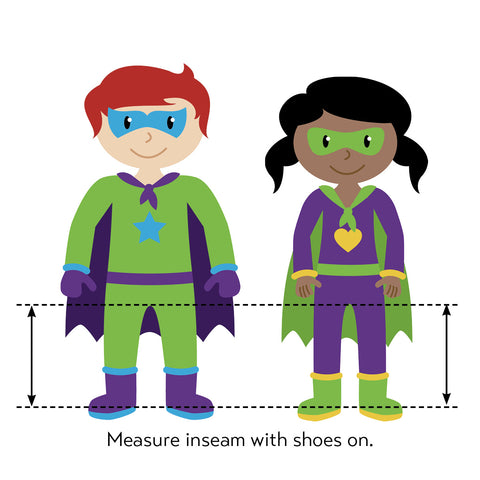Balance Bike Sizing Guide
The ideal position for riding balance bikes is for your child to have the ability to touch the ground flat footed with a small bend in the knee while sitting on the saddle.
There are two ways to determine the best size. The optimal method is to take an inseam measurement. If you are unable to obtain the inseam, use the child's age as the best starting point, and also consider body weight, explained below.
Use an Inseam Measurement

While the child is standing, measure the distance from the ground to the child's crotch. This is easy to do with a tape measure and a hardcover book. Use the book (square it against a wall) to correctly measure to the sit bones by gently pushing the book upwards into the crotch. The idea is to avoid eyeballing a measurement and to instead find the true measure in order to avoid buying a bike that is too small. This is pretty common because the compression of soft tissue, compression of a padded seat, and softness of bike tires is not correctly accounted for, and what you thought was a 13" inseam, is really 14".
Start by looking through the bikes in our Sizing Guide by Ages below and review the minimum and maximum height measurement for the saddle. This should help you identify the bikes that will be a good fit. Take your inseam measurement and use it to narrow your search by minimum seat heights. The minimum seat height can be equal to your child's inseam measurement, because when shoes are worn, there will be an additional inch to work with, and it will provide a slight bend in the knees when seated on the bike. This is what you want.
Another consideration that help to eliminate certain bikes from your list is body weight. Our recommendation is for the child to outweigh their bike by a minimum factor of three. For example: if your child weighs 27 pounds, then their bike's maximum weight should be 9 lbs. Or if the bike you are interested in weighs 12 lbs, the recipient's weight should be at least 36 lbs.
Also keep in mind that balance bikes that are extremely light make the transition to a pedal bike in the future less successful, and sometimes a 2nd balance bike is needed to fill the gap. It is beneficial to consider the weight of the first pedal bike planned for the future. For example, if it weighs 20+ lbs, transitioning from a 5-6 lb balance bike is unrealistic, as it expects the child to handle a bike that weighs more than 3x more. Lighter does not mean better! It usually just means that it's a toy industry product, instead of a bicycle industry product.



